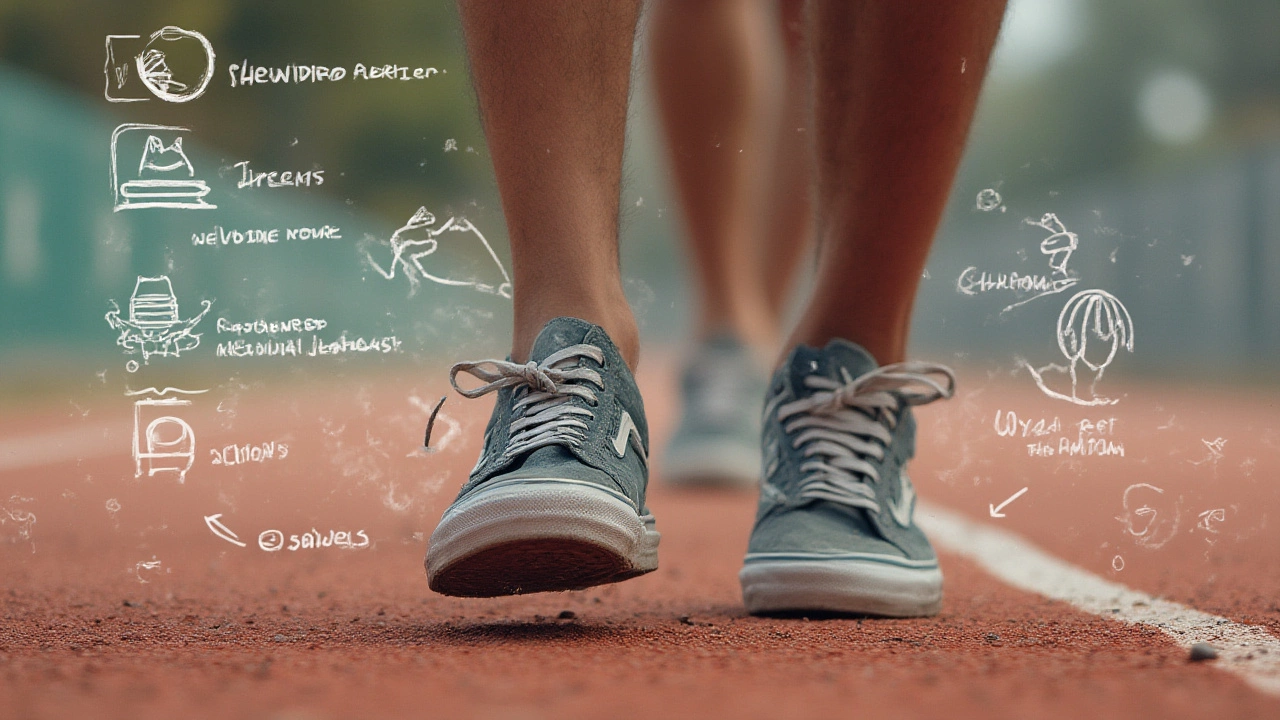Picture this: you wake up in a rush, ready for a morning jog, and the only sneakers staring back from your closet are your trusty Vans. That iconic low-top, skateboard-ready look practically begs for everyday adventures. But are Vans okay for running? This question pops up way more than you'd think—especially if you like to blend style with your workout, or just want to survive that one surprise sports day without splurging on another pair of shoes. Bluntly: there’s fashion, and there’s function. Sometimes, those two worlds do not get along. Curious to see if your classic Vans can double as running shoes, or if that’s a recipe for disaster? Let's get straight into what's really at stake for your feet.
The Anatomy of Vans Shoes: What Are You Actually Wearing?
First off, it’s worth knowing just how Vans are made. The original Vans—think Old Skools, Authentics, and Eras—are skateboarding shoes through and through. They have flat, vulcanized rubber soles made for gripping a skateboard deck and withstanding slides, ollies, and the general abuse that comes with skate culture. That famous waffle outsole you see on most pairs? It’s specifically textured for grip—not for pounding pavement at speed.
The upper part is usually made of canvas or suede, sometimes leather. There’s not much in the way of padding in the heel or around the tongue, compared to actual running shoes. What you get is a snug fit and a look that goes with everything—a Vans trademark. The minimal arch support and stiffness might help with skating’s side-to-side motion, but they don’t really support your foot rolling smoothly from heel to toe, which is key for runners.
Where do running shoes differ? They’re built with “cushioning technologies”—think foam soles, gel inserts, or air pockets—to protect you from the repeated shock every time your foot hits the ground. Running shoes also usually have a raised heel, anatomical arch support, and a flexible toe box to help with your foot’s natural movement. They're built for continuous forward movement, not tricks and stunts.
| Shoe Feature | Vans | Typical Running Shoe |
|---|---|---|
| Outsole | Flat, hard rubber, waffle tread | Cushioned, often flex grooves for movement |
| Upper | Canvas/suede, minimal padding | Breathable mesh, padded for comfort |
| Arch Support | Minimal to none | Designed for natural arch support |
| Shock Absorption | Low | High |
| Heel Drop | Flat (almost zero drop) | 10-12mm (for most models) |
So, if you’ve felt tired or achey after wearing Vans all day (just at the mall, never mind for a run), you’re not alone. They just aren’t engineered for supportive, high-impact movement like jogging or running.
How Running in Vans Really Feels: What Happens on the Go?
Maybe you’ve worn your Vans for a short run or maybe you’ve padded out a few city blocks to catch a bus. But pushing these shoes even further? That’s where the cracks show. Running in Vans, especially on concrete or asphalt, usually means feeling every pebble, crack, and dip underfoot. Because of the flat, hard sole, there’s almost no absorption of shock, so the impact goes right up through your feet, knees, and even your hips.
People who try running in Vans often complain about instant fatigue in their calves and arches. This isn’t surprising—if your shoe lacks arch support, your foot muscles have to work way harder just to keep your stride stable. Runners have even described feeling “slapped” by the pavement with each step, especially on longer distances. Blisters, chafing, and even black toenails aren’t uncommon after even a 30-minute jog if you’re not used to running in stiff, non-cushioned shoes.
Is there a difference if you’re only running a short distance? For a quick dash—think under a mile, and not at sprint speed—you’ll probably survive, especially if you’re young, light, or have extremely tough feet. But risk goes up dramatically with the length and intensity of your run. If you already have flat feet, pronation problems, or bad knees, Vans could make those issues worse quickly.
Another factor: breathability. Canvas looks cool and works okay for walking around, but once you start sweating, the shoes trap heat and moisture. That means higher risk for athlete’s foot or just plain stinky feet. So yes, you could run a 5k in Vans for charity just once, but your body might make you regret it the next morning.

Potential Risks: What Can Go Wrong?
No sugar-coating here. Running in flat, unpadded Vans is kind of like running in dress shoes, just slightly less ridiculous. One of the biggest risks is injury—starting from the bottom up. The lack of shock absorption means your heels and balls of your feet take all the force every time you strike the ground. It doesn’t take much for that pounding to turn into plantar fasciitis (pain in the heel and arch), shin splints, or even stress fractures.
Knees and hips also take a hit, especially if you’re not super light on your feet or naturally built for running. Vans don’t encourage your foot to roll smoothly—you just hit flat, smack the ground, and your legs have to deal with the harsh impact. With repeated, regular running, you’re looking at a higher odds of joint pain or even long-term wear-and-tear injuries.
Balance and stability are another issue. While Vans will grip a skateboard, they’re not stack-stable for sudden lateral (side-to-side) movement. If you jog off a curb or down an uneven path, you’re at a higher risk of rolling your ankle than if you had running shoes that secure your foot and cushion those jolts.
Let’s talk stats for a second. A study by the American Podiatric Medical Association in 2023 showed that over 70% of recreational runners who wore non-running shoes—including skate shoes like Vans—for regular runs reported foot discomfort or pain. Among them, nearly 30% suffered minor injuries (like sprains or bad blisters) within two months, versus under 10% for runners in proper footwear. Not earth-shattering odds, but definitely food for thought before lacing up your Vans for anything more than a quick jog.
When (If Ever) Vans Work for Running
Despite their shortcomings, there could be moments when running in Vans makes sense—or doesn’t do lasting harm. Quick, casual sprints: if you’re dashing across a crosswalk or running for the bus, you probably won’t face any lasting consequences. Skaters who run briefly to build momentum before hitting a ramp won’t notice a thing.
If you’re trying your luck with a laid-back fun run, like a 1K or a family jog, and don’t have actual running shoes handy, Vans will get you through (probably with sore feet the next day). They’re especially okay if you’re under 30, in decent shape, and your run isn’t pushing your limits. But the more often you try this, the higher the chance of stress injuries. The longer you go, the more brutal it gets—especially on hard surfaces.
This is one area where the “barefoot” running craze comes into play. Believe it or not, some runners intentionally seek minimal shoes to “strengthen” their feet. Vans actually mimic a bit of the flat, low-cushion profile of minimalist footwear. But there’s a big caveat—barefoot shoes are flexible, ultra-light, and designed to flex with your foot. Vans are stiff, thick, and often have inflexible uppers, which can restrict natural movement. Only seasoned minimalist runners should even attempt this, and then only for super-short, intentional workouts.
If you’re doing parkour, an obstacle course, or lots of lateral moves, skip Vans entirely. Their lack of stability is dangerous compared to actual athletic footwear built for those motions. And if you’re running on trails or rough terrain? Prepare for sore spots and possible twisted ankles—those classic waffle soles are not made for dirt, gravel, or mud.

Smart Alternatives: How to Run Safely Without Breaking the Bank
If Vans are the only sneakers in your closet, you might feel annoyed by all these warnings. I get it—good running shoes can get expensive, and not everyone wants to own five pairs of sport-specific footwear. But the good news is, there are ways to make things safer or more comfortable, even on a budget.
First, consider an inexpensive, all-purpose athletic shoe. Giant brands like Nike, Adidas, and even Decathlon now make hybrid shoes priced under $50—these provide at least some arch support and cushioning. If you’re intent on making your Vans work, pick a pair with more padding (some Pro models add a bit of cushioning, though it’s still not up to running-shoe levels). If possible, use over-the-counter insoles designed to add soft arch support and absorb shock.
If you decide to run in Vans, keep these tips in mind:
- Stick to grass, turf, or dirt instead of rough pavement or concrete—softer surfaces reduce impact.
- Limit runs to short distances and pay close attention to any foot or knee pain. Stop at the first sign of discomfort.
- Change your socks promptly after running—sweaty, trapped feet are bacteria heaven.
- Rotate with another pair of shoes if you can, to let the Vans air out and regain their shape.
- Listen to your body—persistent aches, numbness, or swelling isn’t normal. Don’t push through pain just for the sake of style.
This debate won’t go away—Vans look amazing, but when it comes to serious running, they honestly fall short. Your feet (and knees) will thank you for finding the right tool for the job, even if it means saving your Vans for post-run selfies.

